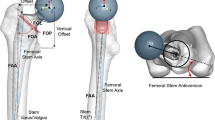Abstract
An accurate three-dimensional morphological analysis of the femur is required to produce well fitting uncemented femoral implants. A computer-aided design system made it possible to produce three-dimensional femoral models and to accurately measure certain parameters with planes standardized for all subjects. The study subjects were Japanese; there were 89 patients (113 hips) with osteoarthrosis (OA) and 18 volunteers (36 hips) free of hip joint complaints and with no abnormal radiological findings (normal; N). The femoral canal was classified into three types, A-I, A-II, and B-II, based on the shape in the frontal and sagittal planes. Either triangular (type T) or circular (type C) shapes were identified at the proximal cross section. Type A-II, which is considered the standard type, accounted for 89% of the N hips, and 42% of the OA hips. Type A-I, with a posterior canal plane strongly inclined toward the anterior, accounted for 26% of the OA hips and 6% of the N hips; 96% of type A-I hips were triangular. Type B-II, which had a steep medial canal plane, accounted for 29% of the OA hips and 6% of the N hips; 63% of type B-II hips were circular.
Similar content being viewed by others
Author information
Authors and Affiliations
Additional information
Received August 5, 1999 / Accepted February 25, 2000
About this article
Cite this article
Kaneuji, A., Matsumoto, T., Nishino, M. et al. Three-dimensional morphological analysis of the proximal femoral canal, using computer-aided design system, in Japanese patients with osteoarthrosis of the hip. J Orthop Sci 5, 361–368 (2000). https://doi.org/10.1007/s007760070044
Issue Date:
DOI: https://doi.org/10.1007/s007760070044




